On Thursday 21st December 2023 we saw that the CSIRO’s 2023-24 GenCost consultation draft was released …. but we’ve only been able to post about it now:
(A) From the CSIRO … and the AEMO
There’s a few different pieces of information at different sites, including the following:
| CSIRO’s draft 2023-24 GenCost Report |
Information on the AEMO website with respect to GenCost |
|
There’s information on the CSIRO website here: From that page, readers can download the (93-page) draft PDF:
|
In parallel, the AEMO published more information about their 2024 Forecasting Assumptions Update Consultation here: … including a link to the CSIRO’s draft report. This followed only a couple days after the publication of the Draft 2024 ISP on Friday 15th December 2023.
|
In this case in the AEMO Newsroom, there does not seem to have been a Media Release published … nor anything specifically on social media about these two releases.
Over at the CSIRO, I did notice that:
1) There was this News Release published…
2) … and also that the organisation tweeted this:
On their website, the AEMO notes here:
‘This draft 2024 Forecasting Assumptions Update uses the latest information available to update assumptions specifically relevant to the reliability assessment for the 2024 Electricity Statement of Opportunities (ESOO).
The updates include (but are not limited to):
(a) Updated Consumer Energy Resources, including Electric Vehicles
(b) Draft 2023-24 GenCost report (CSIRO).’
The key points seems to be that (from an AEMO perspective)
1) Submissions are due to forecasting.planning@aemo.com.au by Friday 9 February 2024; and
2) Consumer advocates can register here to attend a joint verbal submission session from 3-4pm AEDT on Wednesday 7 February 2024.
3) The final GenCost 2023-24 report will be released in the second quarter of 2024.
(B) Media Headlines
A quick scan of the main media outlets at that time, and since, reveals a number of articles:
1) In the AFR …:
(a) Ben Potter wrote ‘Renewables are cheapest, even with poles, wires and batteries added in’ on the morning of the 21st December
(b) At the end of the same day, someone wrote ‘CSIRO’s nuclear cost blowout a shallow analysis – O’Brien’.
2) In the Australian …:
(a) Patrick Commins wrote ‘Nuclear still most expensive energy, says CSIRO’ on 21st December 2023:
(b) Nothing else?
3) In the Guardian:
(a) Graham Readfearn wrote ‘Solar and on-shore wind provide cheapest electricity and nuclear most expensive, CSIRO analysis shows’.
(b) Then Amy Remeikis & Katharine Murphy wrote ‘Pro-nuclear MP says Labor weaponising CRISO report showing renewables are cheapest’.
4) Via RenewEconomy:
(a) Giles Parkinson wrote ‘CSIRO says wind and solar much cheaper than nuclear, even with added integration costs’
(b) Nothing else?
5) In the SMH / Age / Canberra Times:
(a) Marion Rae wrote ‘Steeper cost of small reactors a blow to nuclear push’ .
6) On ABC:
(a) Gareth Hutchins wrote ‘Nuclear energy is more expensive than renewables, CSIRO report finds’ .
(b) Nothing else?
7) In PV Magazine:
(a) On the same day, David Carroll wrote ‘GenCost confirms solar, wind remain cheapest forms of energy’ for PV Magazine Australia:
(b) Nothing else?
8) In InDaily:
(a) Marion Rae wrote ‘Cost update blasts nuclear out of energy mix’ :
9) In EcoGeneration:
(a) A couple weeks later (on Thursday 4th January 2024), Zihan (Fred) Zhang wrote ‘GenCost reveals renewable’s future dominance in Australia’ for the magazine:
… no doubt there are more that I’ve not come across, yet.
(C) On social media
Seeking not to fall into any particular rabbit hole, it’s worth flagging that I have seen quite a lot of commentary on social media in relation to several aspects of the GenCost process – including:
1) A fairly large amount of commentary from those who would seek to promote nuclear technology as a cost-effective means by which Australia might achieve sustainable emissions reductions; and also
2) Others commenting about the ways in which the CSIRO has (as they note as a Key Point in their Media Release) ‘Pre-2030 integration costs now included’ … as a change in their prior process.
3) No doubt there are other particular threads as well.
I could say something like ‘time permitting, would like to review the details of GenCost’ … but I know that, realistically, I won’t have time …


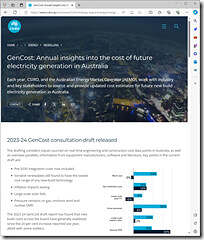
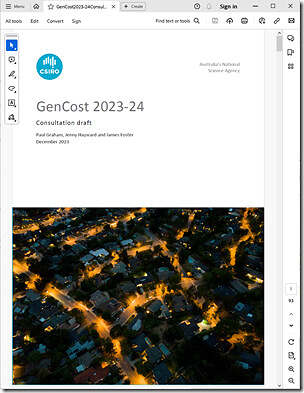
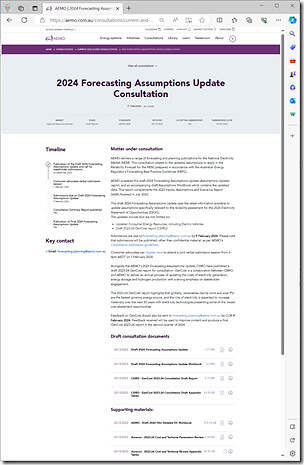
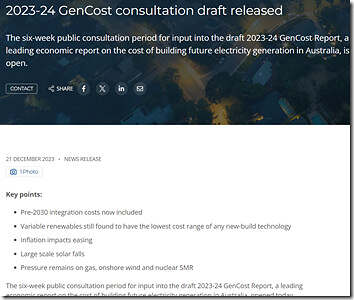
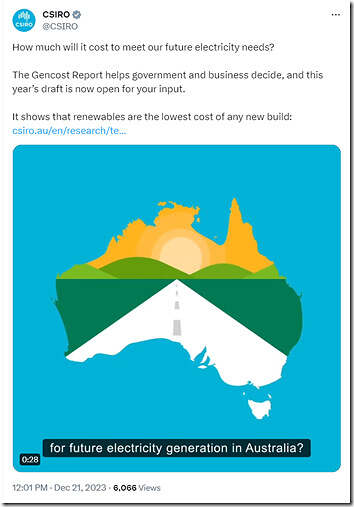
CSIRO has again chosen not to receive expert advice on nuclear costs for their draft GenCost 2023-24 report. Aurecon has again provided expert analysis of all technologies except nuclear. The last time that CSIRO obtained expert advice was from GHD in 2018. For the latest report, CSIRO has attempted to prove by their own analysis that nuclear is too expensive to consider by quoting the cancelled NuScale SMR for Utah Associated Municipal Power Systems (UAMPS) Carbon Free Power project (CFFP) but their analysis is misleading, for example the project was cancelled when the LCOE increased from USD58 to USD89 (at 0.7 exchange rate used by CSIRO = AUD127) but CSIRO quote an LCOE of AUD636. I suggest that CSIRO will need to clarify their analysis for the final report.
And then there is this from the IEA :
(Link at https://www.iea.org/reports/projected-costs-of-generating-electricity-2020)
“Projected Costs of Generating Electricity 2020”
Nuclear thus remains the dispatchable low-carbon technology with the lowest expected costs in 2025. Only large hydro reservoirs can provide a similar contribution at comparable costs but remain highly dependent on the natural endowments of individual countries. Compared to fossil fuel-based generation, nuclear plants are expected to be more affordable than coal-fired plants. While gas-based combined-cycle gas turbines (CCGTs) are competitive in some regions, their LCOE very much depend on the prices for natural gas and carbon emissions in individual regions. Electricity produced from nuclear long-term operation (LTO) by lifetime extension is highly competitive and remains not only the least cost option for low-carbon generation – when compared to building new power plants – but for all power generation across the board.
The International Energy Agency’s next report, due in 2025, will likely be very sobering reading.
My submission to the CSIRO pointed out that they should review nuclear technology costs in their entirety (instead of exclusively SMRs, still under development), and that the coal costs (greenfield, AUSC, Japan coal costs) are not representative of a project that would be built in Australia.
If I cared enough to go further, I’d point out that they use the high performing wind and solar as the average, then assume future projects will be both cheaper and better performing (higher capacity factor), while reality shows the opposite (especially with wind) and that over-build must increase curtailment.
The CSIRO should be embarrassed.